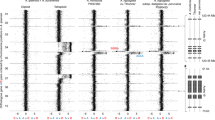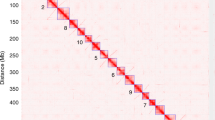Abstract
FOUR different manifestations of the concept of genetic similarity have been demonstrated in the sub-tribe Triticinae. Two of these are at the chromosome level and two are at the gene level. Sears1 demonstrated that each chromosome of hexaploid Triticum has two genetically related chromosomes which are undoubtedly of common origin. These related chromosomes or homoeologues can replace one another without causing serious genetic imbalance. This homoeology extends beyond Triticum to the genera Secale2, Agropyron3 and Aegilops4. Cytological similarity of chromosomes was established by Riley and Chapman5 when they demonstrated that particular non-homologous chromosomes of Triticum and of Triticum and Aegilops have the potential to pair or synapse with one another. Similarity at the phenotypic level of gene expression was examined in detail by Sears6 in his study of Neatby's virescent gene. He showed that there exist three genes affecting chlorophyll production in a similar manner. The three genes are carried on the three chromosomes of homoeologous group 3. We have demonstrated similarity at the level of enzymatic gene-products7 and the existence of isoenzymatic proteins which are capable of hybridization. These proteins are produced by a particular rye chromosome, its wheat homoeologue of the A genome and apparently the homoeologues of the other two wheat genomes. Recent evidence, which will be published in detail later, supports the involvement of the homoeologues of the B and D genomes. These four patterns of similarity are compatible with one another.
This is a preview of subscription content, access via your institution
Access options
Subscribe to this journal
Receive 51 print issues and online access
$199.00 per year
only $3.90 per issue
Buy this article
- Purchase on Springer Link
- Instant access to full article PDF
Prices may be subject to local taxes which are calculated during checkout
Similar content being viewed by others
References
Sears, E. R., Res. Bull. Mo. Agric. Exp. Stat., 572 (1954).
O'Mara, J. G., Genetics, 32, 99 (1947).
Knott, D. R., Proc. Tenth Intern. Cong. Genet., 2, 148 (1958).
Riley, R., Chapman, V., and Johnson, R., Nature, 217, 383 (1968).
Riley, R., and Chapman, V., Nature, 203, 156 (1964).
Sears, E. R., Genetics, 44, 534 (1959).
Barber, H. N., Driscoll, C. J., Long, P. M., and Vickery, R. S., Nature, 218, 450 (1968).
Acosta, C. A., Dissertation Abstracts, 23, 34 (1962).
Author information
Authors and Affiliations
Rights and permissions
About this article
Cite this article
BARBER, H., DRISCOLL, C., LONG, P. et al. Gene Similarity of the Triticinae and the Study of Segmental Interchanges. Nature 222, 897–898 (1969). https://doi.org/10.1038/222897a0
Received:
Issue Date:
DOI: https://doi.org/10.1038/222897a0
This article is cited by
-
Variation of leaf esterases in some Ethiopian tetraploid wheat landraces
Genetic Resources and Crop Evolution (1996)
-
Mating system and genetic differentiation inDasypyrum villosum (Poaceae) in Italy
Plant Systematics and Evolution (1995)
-
Genetic linkage map of rye (Secale cereale L.)
Theoretical and Applied Genetics (1992)
-
Genetic characterisation of a further homoeoallelic series of grain esterase loci,Est-6, in wheat
Theoretical and Applied Genetics (1990)
-
Chromosomal location of isozyme and seed storage protein genes in Dasypyrum villosum (L.) Candargy
Theoretical and Applied Genetics (1987)
Comments
By submitting a comment you agree to abide by our Terms and Community Guidelines. If you find something abusive or that does not comply with our terms or guidelines please flag it as inappropriate.



